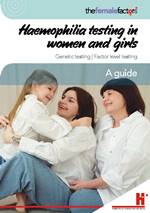
Haemophilia testing in women and girls: a guide
(shorter/simpler version)
This booklet is a simple guide to the steps involved in genetic testing and factor level testing for haemophilia in females. It is aimed at women, teenage girls and parents of girls to explain what is involved in the tests and answer some common questions.
It has infographics, tables and relatable stories to help with clear explanations.
Download the full booklet 3.7 MB
Read the booklet online (ISSUU)
A guide to haemophilia testing sections
Why test for haemophilia in women and girls?There are important reasons for testing for haemophilia in women and girls. This section explains briefly why you or your daughter might be tested and the types of testing. It includes relatable stories as examples. |
Understanding haemophiliaThis section gives some background information about haemophilia – what causes it, how common it is, symptoms and how it is treated. It explains how haemophilia is related to factor VIII (8) or factor IX (9). It also includes an infographic showing the differences in severity between males and females. |
How is haemophilia diagnosed?A brief outline of the steps in diagnosing haemophilia in women and girls. |
Providing a bleeding historyAs a first step in diagnosis, your specialist doctor or haemophilia nurse will ask you some questions about your bleeding problems over your lifetime. This section outlines the questions and the signs that suggest you might have a bleeding tendency. |
Genes and inheritanceHow is haemophilia inherited? What if there is no family history of haemophilia? What is a haemophilia carrier? This section explains the ins and outs of genes and chromosomes and how haemophilia is passed on in a family (with diagrams). It also walks through X-inactivation (with stories and diagrams) and explains simply why female bleeding patterns can vary so much, even in the same family. |
Genetic testing and counsellingThis section explores common questions about genetic testing and genetic counselling. What are the steps in genetic testing? Should you or your daughter have a genetic test? When to test? How do you decide? Who can help you? It includes infographics, relatable stories and personal experiences. |
Factor level testingWhy would you have factor level testing? This section explains who should have factor level testing, with an infographic showing when to have testing over your lifetime. It also covers what's involved in the test and what your results mean. |
Your diagnosis and treatmentWhat does your diagnosis mean? This section includes a table outlining the terms and their meaning. It explains a treatment plan and gives some tips on what to tell your GP and other health professionals. |
Telling othersAre you wondering how to tell your partner or your family? Do you need to tell your employer or insurance company? This section gives some practical advice. |
How are you feeling?Being diagnosed with haemophilia or as a 'carrier' can affect people in very different ways. This section outlines the support available for you, your partner and family. |
March 2023 edition
OTHER RELATED BOOKLETS
Haemophilia testing in women and girls: your questions answered
Haemophilia: finding out you carry the gene PDF 1.4MB
Telling others about bleeding disorders: information for women, girls and their parents
